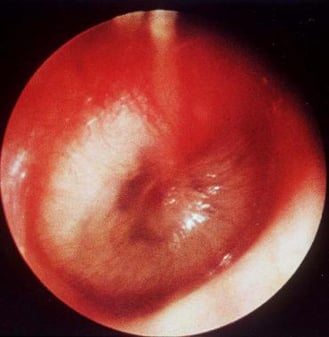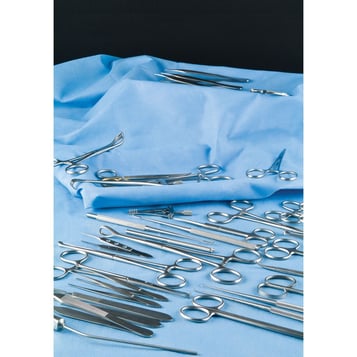Acute ear infections affect one in ten people worldwide, and children aged five and under account for half of the cases. Five percent of those with the acute stage eventually develop chronic otitis media (COM) with a significant portion of patients under age five.1 This condition is a persistent infection which does not heal properly and oftentimes does not respond to medical treatment. In these cases, surgical intervention may be required to get rid of the infection.
What causes Otitis Media? Image courtesy of Emedicine.medscape.com
 The most common cause of otitis media is a malfunction of the eustachian tube which runs from the middle ear to the back of the throat.2 The eustachian tube normally drains fluid from the middle ear. Allergies, the flu, a cold, or a sinus infection can cause the tubes to swell and get clogged. When this happens, fluid gets trapped in the middle ear, easily resulting in an infection. Young children are more prone to develop this type of infection because their Eustachian tubes are shorter and more horizontal compared to older children and adults.3
The most common cause of otitis media is a malfunction of the eustachian tube which runs from the middle ear to the back of the throat.2 The eustachian tube normally drains fluid from the middle ear. Allergies, the flu, a cold, or a sinus infection can cause the tubes to swell and get clogged. When this happens, fluid gets trapped in the middle ear, easily resulting in an infection. Young children are more prone to develop this type of infection because their Eustachian tubes are shorter and more horizontal compared to older children and adults.3
Complications of COM, and Initial Treatment Options
When over-the-counter analgesics aren’t providing relief, in most cases an ENT will prescribe oral antibiotics, antibiotic ear drops, or a combination of both if necessary. If the infection does not respond to second or third line antibiotic treatment, then surgery may be needed to address the issue. A chronic ear infection can cause severe hearing problems. Such a hearing deficit in young children can lead to speech and language problems early in their development. An untreated chronic ear infection can also lead to other complications, including:
- Damage to the bones and middle ear
- Infection in the mastoid bone
- Damage to the balance function of the ear
- Drainage from a hole in the eardrum
- Tympanosclerosis
- Cholesteatoma
- Facial paralysis
- Inflammation in the brain4
Types of Surgery
Surgical intervention is necessary when ear infections recur and/or there is a high risk of hearing loss or irreversible damage to the ear drum. The most common ear surgeries are:
Bilateral myringotomy – The surgeon makes a tiny hole in the eardrum and sucks fluids out of the ear, then, a small tube is inserted through the hole to help in further drainage. These tubes usually fall out on their own after 6 to 18 months. If they don’t, then they may have to be surgically removed.
Myringoplasty – This surgical procedure closes the middle ear in a natural way and may improve hearing. It repairs a hole in the eardrum when the infection is not present in the middle ear or ear bones.
Tympanoplasty – Its purpose is to repair a hole in the ear drum or tympanic membrane to reduce hearing loss. An incision is made behind the ear, then the middle ear is padded with absorbent material. A graft is taken from the temporalis (chewing muscle) and placed under the perforated ear drum. The incision is closed with absorbable sutures. The success rate of this operation is 90%.5
Mastoid Tympanoplasty – This surgery is for chronic infection or skin sack formation, known as cholesteatoma. In this surgery, the mastoid air cells are removed and the ear drum and ear bones are repaired. An incision is made behind the outer ear. The outer layer of bone is removed and the infected content is cleaned out. Sometimes, the ear canal gets enlarged into the mastoid to provide better draining. This operation is done under general anesthesia and may last two to three hours. After completion, the incision is closed with dissolvable sutures that require minimum care.
Meatoplasty – Sometimes, when a radical mastoid surgery is necessary, the ear canal needs to be enlarged by removing portions of the cartilage in the ear. In doing so, the mastoid cavity can be cleaned easily. In a radical mastoid surgery, or mastoidectomy, the infection is removed without considering hearing improvement. It is only performed in cases where infections become extremely resistant. This decision is usually made during mastoid surgery, if the doctor sees that there is no other alternative to get rid of the infection.
Atresia Repair – Sometimes the ear canal will close due to infection. An incision is made behind the ear and a new canal is drilled through the mastoid bone. A new ear drum is made with a graft from the chewing muscle, and a skin graft from the inside of the upper arm is used to line the new ear canal. A new opening is made in the outer ear with the skin graft sewn to this opening. This surgery is done under general anesthesia and an overnight hospital stay is required.6
 Please feel free to add your comments about your experience with these types of surgeries, your regional incidence of chronic otitis media, or relevant articles and current research.
Please feel free to add your comments about your experience with these types of surgeries, your regional incidence of chronic otitis media, or relevant articles and current research.
To learn more about Sklar’s high-quality ear, nose and throat surgical instruments please click the button below.
Shown: Middle Ear Tray, Sklar product number 98-1475
Related links:
American Academy of Otolaryngotomy-Head and Neck Surgery
American Academy of Pediatrics
National Institute on Deafness and Other Communication Disorders
References:
1 Monasta, L; Ronfani, L; Marchetti, F; Montico, M; Vecchi Brumatti, L; Bavcar, A; Grasso, D; Barbiero, C; Tamburlini, G (2012). "Burden of disease caused by otitis media: systematic review and global estimates."
2, 4 Martel, Janelle, Chronic Ear Infection (November, 2015).
3 Kivi, Rose; Yu, Winnie, Acute Otitis Media (January, 2016).
5 Ear Infections & Surgical Treatment.
6 Ear Surgeries Commonly Done at the Atlanta Ear Clinic.



